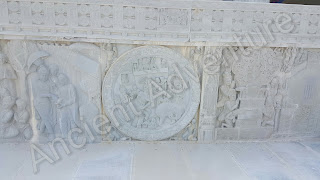The Nagarjuna Sagar Museum is located on the way to the dam and houses beautiful sculptures reflecting the architectural beauty of the Ikshvaku dynasty that made Nagarjuna Konda their capital.

It is situated on the border of Nalgonda/Guntur district. It is approximately 153 kms away from Hyderabad and the roads are pretty good to drive.
The Nagarjuna Sagar dam submerged an ancient Buddhist settlement, Nagarjunakonda, which was the capital of the Ikshvaku dynasty in the 1st and 2nd centuries, the successors of the Satavahanas in the Eastern Deccan. The Ikshvakus patronised Hinduism and Buddhism and the famous Acharya Nagarjuna is said to have taught at Nagarjunakonda in its heyday.
The Nagarjuna Sagar museum has replicas of sculpture that highlight Buddhism in the region. As one walks around the museum the walls are rich with images that talk about the birth of Buddha, Maya’s dream, Buddha Paduka, the poorna kumbha or kalash, peepal tree and mithuna couples. It is a visual treat to walk around and absorb the intricate details that adorn the images.
 |
 |
 |
 |
 |
 |
A replica of the Amaravati Stupa based on the original Amararama stupa is being built in Nagarjuna Sagar. The Amararama was considered to be the biggest stupa in the South. The stupa has a Vedika or drum on the dome. The walls of the stupa are carved with scenes from Buddha’s life and the sculptural panels depict Theravada Buddhism which was promoted by the rulers. The circumambulatory passage has scenes from the Jataka tales, the Bodhi tree, and the paduka of Buddha. The Buddha Charita Vanam houses images of Buddha, the peepal tree and one can walk around reading about Buddhism in this region.
 |
 |
 |
 |
The museum is closed on Friday. A visit to this museum brings to light the lost glory of the Ikshvakus and their secular faith in the 1st and 2nd centuries. As we drove towards the dam we could not help but wonder how much of history is submerged under the waters and raises the question of what happened to the relics lost during the construction of the dam. No doubt the region benefits from the waters released for harvest, but a sense of sadness envelops when remembering a legacy that is now under water.
















